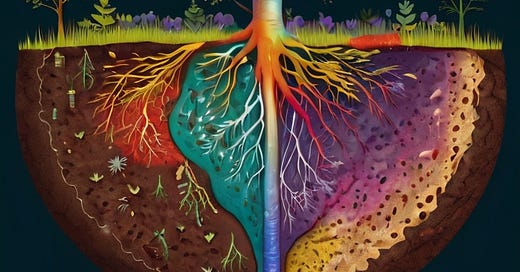

Discover more from The Ecological Mind: ecology, research, creativity
Do we need more soil art?
With soil not inherently aesthetically attractive, we need all the help we can get
Soil for most people is not love at first sight. As opposed to many flowers or animals it is not inherently beautiful or aesthetically pleasing. It is certainly very important for human affairs, and realization about this is becoming widespread, but we don’t generally find it inherently beautiful. On the contrary, for most people it is what we scrape off our shoes as dirt.
It helps to appreciate that soil is full of life. Literally full, with a recent paper in PNAS suggesting that there is more diversity in soil than above the ground. But this kind of life, mostly microbial and embedded in an opaque matrix, is inaccessible and invisible. And thus we don’t put pictures of soil or soil life on our walls or greeting cards, but of plants and their flowers and animals.
I don’t know if this is a problem, but I feel it could be. If something is aesthetically appealing it seems much easier to make a case for its protection, for example. Arguments for protection of soils are utilitarian: it’s important for producing food, stores carbon and so on.
My own interest in soil is scientific, there is not really an aesthetic component. This is why I made the choice to work on soils: I thought this is where there is still a lot to discover, and that turned out to be true. But beyond this scientific fascination with the soil, I think I have no particular emotional connection to it. I do find fungi beautiful, and also some of the other inhabitants.
So this brings me to my question from the title of this newsletter: do we need more soil-related art? I think we do. Because this could be a way to get people to think about soil not just from a utilitarian perspective, but to highlight the aesthetic sides of soil and its inhabitants.
In her current exhibit at Art Laboratory Berlin, Saša Spačal, a Slovenian artist who we have hosted several times in our lab, has produced such an effect in a part of her work on display. While working with the effects of pollutants on soil, she created so-called soil chromas (chromatography) on filter paper, which reflect some properties of the soil in terms of migration patterns of soil organic material on filter paper. The effect overall is aesthetic, and because of their beauty, I believe these soil chromas make people curious about soil and the effects pollutants have on it.

There are many more examples of this. What is your favorite soil art? Please share in the comments!














I agree so much! Funny what you say about flowers, it's true, they are so easy to look at that they even make me question my work with them sometimes! (I make art under the microscope using plants).
Recently I started looking at soil under the microscope too. It got me thinking about the high diversity it has, both biologically and aesthetically, that can be seen at just 10X magnification. Aesthetically i find it beautiful, it's like a set design from a George Lucas movie.
Although I know theoretically about the biodiversity and complexities of soil I felt an extra connection when looking at it under the microscope. After seeing these beautiful micro-landscapes with their cute and monstrous inhabitants I wanted to keep the little soil samples as if they were living treasures.
I think the direct and magnified visual connection is a key point of access to the interest and love for soils.
Thanks for the writings and for giving art a place in science!
We really need more soil art. I've been diving deep into the world of Arbuscular Mycorrhizal fungi (AMF) during my PhD., snapping loads of microscope pics of their structures in soil and roots. It's not just for research—it's crazy beautiful and fascinating stuff. On the side, I've got artists getting inspired by what I see through the microscope, turning it into awesome drawings and paintings. I think we got to shout more about the underground microbial scene, giving unseen microbes an artistic spotlight, from microscope to f(r)ame.